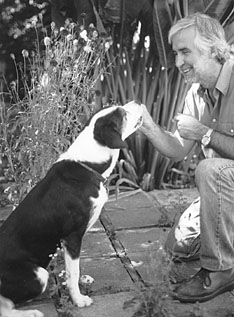by Nancy Kerns
In the opening ceremonies of the 10th annual conference of the Association of Pet Dog Trainers, held last fall in Orlando, Florida, APDT founder Ian Dunbar offhandedly stated that he was performing the role of the conference’s opening speaker for the last time.
A native of Britain, Dunbar earned his veterinary degree in that country, but came to the U.S. to conduct further research into canine behavior at the University of California, Berkeley. After earning his Ph.D. there, he founded Sirius Puppy Training, the first and best-known provider of puppy training classes. Dr. Dunbar is widely credited for popularizing dog-friendly training methods in recent decades, thanks to his appearance at hundreds of lectures (his best guess is that the number is over 850), and a number of books and videotapes he’s written, published, and produced. He’s been tireless for decades; he’s not retiring and quitting all that, is he? We had to find out.
Recently, we sat down with Dr. Dunbar so we could catch up on news of his latest plans and projects – and ask him why he wasn’t planning to welcome the members of APDT to their annual conference anymore.
———-
WDJ: At the last APDT conference, I heard you say you were done with giving the opening speech; why?
Dunbar: Well, I’ve done 10 of them now. That seemed like a good, round number. And they have plenty of interesting, knowledgeable people to give that speech. It seemed to me that it was a good time to stop. I’ll always make myself available to them if they need me to speak about anything else. And I’ll always be present at the APDT meetings; there is no better educational conference for dog trainers in the world.
WDJ: You had us worried that you were retiring . . .
Dunbar: Not for a couple more years. I have one more project I want to concentrate on for a while.
WDJ: Which is?
Dunbar: I want to spend the next few years publicizing the importance of training and preventing behavior problems in dogs. Trainers and veterinarians today are pretty well educated in behavior, which was not the case 20 years ago. Pet dog training did not exist then, and veterinary behaviorists did not exist, apart from very few university-based academics. But the general public today is still relatively unaware of dog-friendly training.
Don’t get me wrong; the general public knows a lot more now than they used to! For example, people go to puppy classes now; there didn’t used to be puppy classes! But most people still don’t know that dog training is fun, easy, effortless . . . it’s actually what owning a dog is all about! It’s communicating and developing a relationship with a dog.
So, that’s it. I’m going to spend two or three more years really trying to push this stuff through the media.
WDJ: We can help with that! What is the most important thing you want dog owners to know? The most important thing for prospective dog owners to understand is that they can’t wait until a puppy is 12 weeks old to start working with him. So many dogs are developmentally retarded – irretrievably. Development is a great opportunity, but it can’t be missed; if you’ve missed it, you’ve missed it. If you have a shy puppy, you cannot mend him. You can improve him so he can function in society, but he will never be what he could have been. The intervention has to be as early as possible.
Dunbar: I think the best way to go is to intervene with prospective puppy owners, because they interface with the source of puppies: breeders. They can say to a breeder, “I’m sorry, the puppy is eight weeks old already! Why isn’t he housetrained? Chew-toy trained? Doesn’t he know how to come, sit, lie down, roll over? What have you been doing? Hasn’t he been handled by 50 people, 10 of them children? Why have you wasted eight weeks, two-thirds of the critical period of socialization?!” I have tried directing this message to kennel clubs and breeders, and a lot of them listen and do an incredible job, but a lot of them don’t.
But when the people who buy puppies are put in the driving seat – I think that’s the secret. We have to give pet dog training back to pet owners and let them know, “Look, you choose. You could get a lemon quite easily. You could get a puppy that is so ruined at eight weeks that it’s going to impact your life for the lifetime of the animal, 14 years, say. You’re going to be 14 years living with a dog who’s shy of strangers, your friends, relatives.” That’s a chunk out of your lifestyle. So think before you get that shy puppy! Tell that puppy producer, “Sorry, you didn’t do neonatal handling exercises. I’m going to buy my puppy elsewhere.”
WDJ: Is this message too discouraging to people who adopt older shelter dogs? If a puppy is “made” or “ruined” by 12 weeks, should people avoid getting older dogs?
Dunbar: No, no. I encourage people to get shelter dogs, but I ask them to be discerning. You have to look long and hard. If you look, the right animal is always there. It may have behavioral baggage, though. I think we do have to get stricter about what we adopt out to unsuspecting pet owners, especially with the whole fearfulness/aggression issue. If the animal is fearful, we need to tell the owner how to rehabilitate it, number one. Number two, we have to inform them that it will be a lengthy process, and not kid them that the animal is “just shy today.”
With animals that do damage, I don’t think they are suitable for adoption. They are the reason that I very strongly take exception with the “no kill” concept. Some animals have been damaged so badly that they now damage people. You can’t in good conscience, I think, set that animal loose on the unsuspecting general public. Some animals have to be euthanized. And I think it’s ridiculous to send them to some sanctuary where millions of dollars are spent keeping dangerous animals alive. What kind of life is that for the animal? I think it’s better to euthanize, and euthanize is the word I would use. It means to kill in a pleasant, non-painful way.
Even in my puppy books, I encourage people to get adult dogs. If you look with your head as well as your heart, there will be the perfect adult dog for you at a shelter.
But here’s the question to ask: Where do all these shelter animals come from? They were all three-week-old neonates once; that’s where they all got screwed up, that’s what we have to impact …
I’m getting toward the twilight of my career, I hope. I’m looking forward to gardening, and construction on the house, and writing. But I want to spend two or three more years trying to promote the education of prospective puppy owners. Selecting a puppy is no different from selecting a school for their kids, or buying a new car. You have to be really discerning.
For decades, dog owners have been bullied by the animal professions. There are a lot of breeders and vets who deliver their opinions in such a way that the owner has to take it as gospel, or go elsewhere, and they end up being bullied into taking an eight-week-old puppy that is behaviorally retarded. And not because there was anything wrong with it when it was born! It hasn’t had an education!
I just don’t understand how you could raise a puppy, and keep him until eight weeks – which, I have to stress again, is two-thirds of the critical period of socialization – and not invite anybody over to handle, hand-feed, and train him. If you haven’t housetrained or chew-toy-trained him, and he’s peeing and pooping everywhere, chewing everything – well, that’s what he’s going to do in the new home! The prospective owner gets duped.
Having said that, I must add that there are some brilliant breeders out there, and brilliant veterinarians who really get it, but that has not always not been the case, and it’s still not the case with all of them.
WDJ: Surely things have gotten better for dogs … We’ve come a long way in the last 20 years, haven’t we?
Dunbar: Well, yes, of course. The research I did in the 1960s and 70s is now common knowledge for pet owners. Most of them have a passing familiarity with concepts like socialization and behavior modification today. That’s exciting.
On the other hand, so many people live with dogs who do things they don’t like – it’s too silly for words! Especially since the behavior problems that dogs have are so easily treatable, and the temperament problems are so easily preventable.
Twenty or 30 years ago, the solutions to a lot of dog behavior problems were not there, but we have answers for most of them now. It’s not rocket science. These problems are simple; they are just behavior problems, and very easy to cure. The temperament problems – you must prevent them. And the general public needs to know how easy it is.
WDJ: Is this why you make some of your educational materials available for free?
Dunbar: That’s always been my philosophy. When I started lecturing, I always allowed anybody to tape my lectures. At Sirius, we’ve always allowed anyone to observe the classes. We have trained all our competition, Bay Area-wide, nationwide, worldwide, and I’m happy about it. Come and learn. And one special book – Before You Get Your Puppy – it’s so important that we plan to make it available for free download. Some people will still buy it, I suppose; it’s nice to have in book form.
WDJ: You also wrote After You Get Your Puppy, to help people with problems that arise after the puppy comes home. I noticed that the “before” book is much lower-priced!
Dunbar: Ah, you noticed! Doesn’t that make sense? The price of solving problems is higher than preventing them in the first place!






